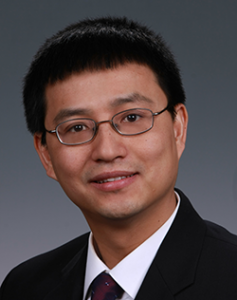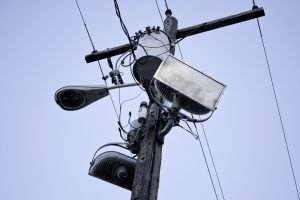
June 6, 2017 WSU Tri-Cities alumnus using degree to advance world’s largest man-made machine
By Maegan Murray, WSU Tri-Cities
The United States power grid is connected by more than 450,000 miles of high-voltage transmission lines to provide electricity to more than 300 million people. But as the saying goes, with great power, comes great responsibility.

Yousu Chen – PNNL
With the increase of renewable energy sources, the growth of the increasingly complex system and increases in terrorist threats, engineers have to come up with new methods to protect the power grid.
Yousu Chen (WSU Tri-Cities MS, environmental engineering), staff research engineer at the Pacific Northwest National Laboratory, is using high-performance computing techniques to safeguard the electrical grid against potential threats and outages.
“The power grid is the largest man-made machine in the world,” he said. “It is the most important infrastructure, and we need it daily for almost all of our daily activities. I’m always eager to know what I can do in this fast-growing area to solve new problems.”
During his time as a student at WSU Tri-Cities, Chen got his first internship at PNNL. He also learned skills in simulation and modeling that have proven invaluable to his career.
He has been involved in the Institute of Electrical and Electronics Engineers, increasing opportunities for current students.
Solving problems before they happen
Chen‘s work focuses primarily on modern computing techniques that both simulate potential hazards and provide ways for monitoring information within the grid. Through the advancement of high-performing computing techniques, he and his team at PNNL are developing simulations to predict and combat problems before they occur.
Chen’s computing systems utilize complex algorithms to measure power flow, identify potential problem areas, simulate possible outcomes if there were to be an outage or a catastrophic event, as well as provide solutions in how to deal with those potential problem areas.
“For example, if we want to evaluate the impact of newer smart grid technologies on the power grid, we use our simulation techniques to prepare for the event before we apply those new technologies to the grid,” he said. “Using our simulation, we could determine how that issue would impact the grid, and as a result, how we can prevent that from occurring.”
Chen said he and his team are always developing newer computing techniques to run simulations at a faster rate, which will be crucial in the event of a major outage or disruption.
“Some systems will take minutes, depending on the system, to run a limited number of contingencies,” he said. “My code is able to run 1 million contingencies in less than 30 seconds. That is a major achievement.”
With all of the data generated through advanced computing methods, Chen and his team are also always looking take the massive data caches and efficiently turn them into something usable and visual.
“Because high-performance computing systems can create a lot of data, it is challenging to digest that data in the short-term,” he said. “We develop advanced visualization tools, which allow us to view that data in real time and provide a quick response for potential events.”
Giving back to the future of engineering
Even though Chen has achieved much in his career as an engineer, he has used his position to increase opportunities for disseminating knowledge of his field into the community, as well as create pathways for other students to follow in his footsteps.
Chen realized early in his higher education career just how valuable mentorship and extracurricular learning experiences could be to his own growth as an engineer. In addition to utilizing university resources to connect him with an internship at PNNL, he also sought advice for how to improve his resume, his interview skills and more through the university’s career development center. After landing a full-time position of his own at PNNL, he wanted to keep paying forward what he learned, using his connections in engineering and computer science to provide resources and mentoring to aspiring engineering students.
 Chen has since volunteered his time through a variety of capacities for the Institute of Electrical and Electronics Engineers. He serves as chair for the IEEE’s distinguished lecture program and formerly served as the regional representative of the IEEE Power & Energy Society and the regional chair for the IEEE Power Energy Society’s scholarship plus program. He also serves as the editor for two professional journals where he helps edit and review articles for publication pertaining to the smart grid.
Chen has since volunteered his time through a variety of capacities for the Institute of Electrical and Electronics Engineers. He serves as chair for the IEEE’s distinguished lecture program and formerly served as the regional representative of the IEEE Power & Energy Society and the regional chair for the IEEE Power Energy Society’s scholarship plus program. He also serves as the editor for two professional journals where he helps edit and review articles for publication pertaining to the smart grid.
As a result of his efforts, Chen was recently awarded the Institute of Electrical and Electronics Engineers’ Leadership Award for the contributions he has made to IEEE activities and the leadership he’s displayed through IEEE at the local, regional and national levels. In a congratulatory letter, Wai-Choong Wong, vice president of the member and geographic activities at IEEE, stated that Chen has set a great example in carrying forward the goals and objectives of the IEEE MGA board.
Chen said he is grateful for all he learned in his education at WSU Tri-Cities, as well as what he has been able to accomplish since then by means of his work at PNNL, as well as through his involvement with the IEEE.
“These opportunities changed my life,” he said. “I’ve been fortunate to accomplish a lot in my career as an engineer and I believe it is my responsibility to not only increase the capabilities of the power grid, but to also increase the potential for the world’s future engineers who will solve many of these energy-related problems.”





